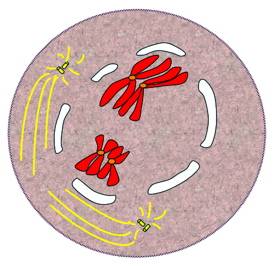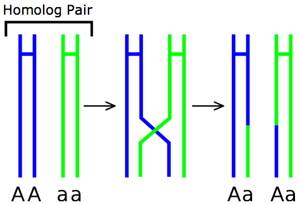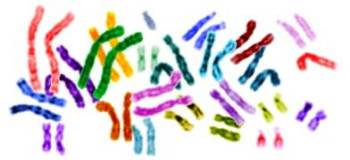Prophase I
EUGENE M. MCCARTHY, PHD GENETICS
| < | Mitosis | Meiosis | > |
Prophase I

 Diagram of crossing-over. Note that while crossing over is shown here, for simplicity, between only one of the two chromatids of each chromosome, each chromatid of each chromosome actually synapses with one of the chromatids of that chromosome's homolog. So crossing-over between both of the synapsed chromatid pairs does occur.
Diagram of crossing-over. Note that while crossing over is shown here, for simplicity, between only one of the two chromatids of each chromosome, each chromatid of each chromosome actually synapses with one of the chromatids of that chromosome's homolog. So crossing-over between both of the synapsed chromatid pairs does occur. A human karyotype colored
to show chromosome pairs
(Enlarge)
A human karyotype colored
to show chromosome pairs
(Enlarge)
During this phase of meiosis, the nuclear envelope (shown in white in the diagram at right) breaks up and disappears. The nucleolus also vanishes. The chromosomes (shown in red) become visible as they shorten, coil, and thicken (that is, as they "condense"). Also, the spindle apparatus (yellow strands in the diagram) begins to extend outward from the two centrosomes, which move to the opposite ends ("poles") of the cell.
Each chromosome is composed of two sister chromatids containing identical genetic information. During most of meiosis (through the end of metaphase II) the sister chromatids remain attached to each other at the centromere.
During prophase I the two members of each homolog pair become intimately associated along their entire lengths (that is, they "synapse") to form a structure known as a tetrad (or bivalent).
In the upper diagram two tetrads are represented as two x-shaped chromosomes associated side by side. This is to show that the two chromosomes of each homolog pair adhere to each other during this phase of meiosis. But the appearance of a tetrad changes in the different substages of prophase I (read about these substages >>). Early on during prophase, the two chromosomes of which a tetrad is composed fuse together so tightly that they cannot be distinguished from each other, which is called synapsis. Only later do they become separately visible.
Next page >>
|
Crossing over. Normally, the two chromosomes making up a homolog pair are not genetically identical — as is the case with sister chromatids — because homologs are inherited from different parents. When the chromosomes synapse during prophase I, each gene in each chromosome is brought into contact with the same gene on that chromosome's homolog. During this process of synapsis the two chromosomes of each homolog pair exchange segments of DNA in a process known as crossing over. As a result, the gene combinations on a chromosome can be changed. For example, suppose one chromatid of a chromosome initially contained genes for brown eyes and brown hair. After crossing over, it could contain genes for blue eyes and brown hair, by taking the gene for blue eyes from one of the chromatids of that chromosome's homolog (see figure right). No crossing over occurs between sister chromatids. |